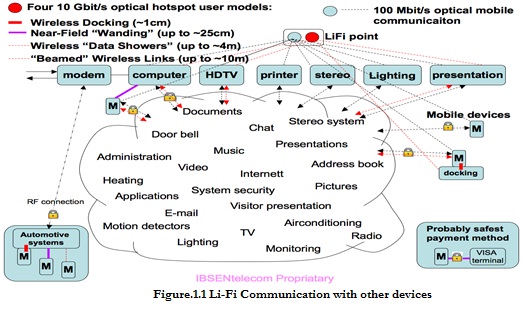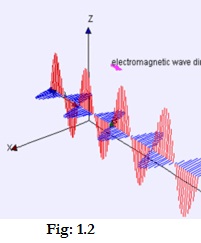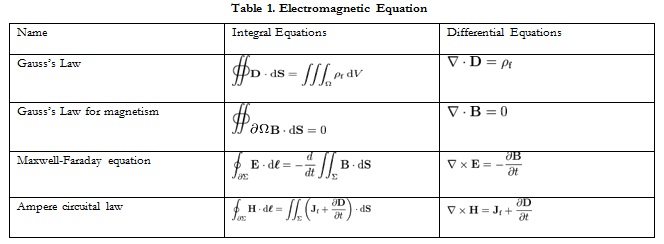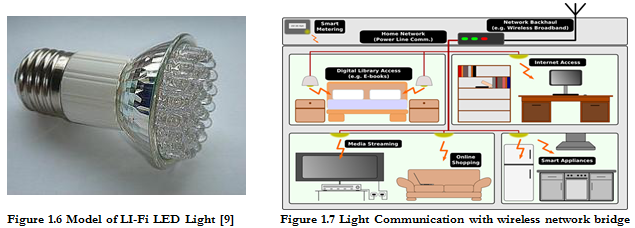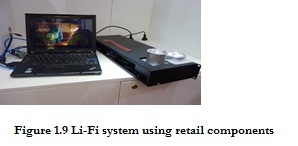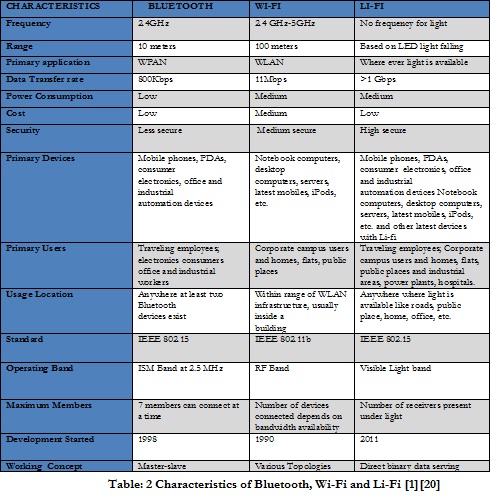Title: Li-Fi Technology in Wireless Communication
Author: Revathi Ganesan, 3rd Year, BE, ECE Department
College: Madras Institute of Technology, Anna University, Chrompet
1) ABSTRACT
Li-Fi or Light Fidelity refers to 5G Visible Light Communication systems using light-emitting diodes as a medium to high-speed communication in a similar manner as Wi-Fi.[13] In the days where internet has become a major demand, people are in a search for Wi-Fi hotspots. Li-Fi or New Life of data communication is a better alternative to Wi-Fi in wireless communication. This paper proposes a survey on Li-Fi Technology. The Li-fi technology was invented by Professor Harald Hass of University of Edinburgh. Li-Fi has more capacity in terms of bandwidth in visible region therefore it does not poke its nose in other communications which uses radio frequency range, without taking its frequency bands. Li-Fi has thousand times greater speed than Wi-Fi and provides security as the visible light is unable to penetrate through the walls, which propose a new era of wireless communication.[18] The concept of Li-Fi is data communication on fast flickering of light which is not detected by human eye but it is focused on photo detector which converts the on-off state into binary digital data. It has gained a huge popularity in two years of its invention. Such technology has brought not only greener but safer and cheaper future of communication.[14]
KEYWORDS: LED (Light Emitting Diode),Wi-Fi (Wireless Fidelity),Li-Fi (Light Fidelity),VLC (Visible Light Communication),RF (Radio Frequency).
2) INTRODUCTION
The concept of Li-fi is currently attracting a great deal of interest, not least because it offers a genuine and very efficient alternative to RF.As a growing number of people and their recent device access wireless internet, the airwaves are becoming increasingly clogged and unavailability of free bandwidths to every device, making it more and more difficult to get a reliable, high speed signal. The opportunity to exploit a completely different part of the electromagnetic spectrum is very appealing. Li-Fi has other advantages over Wi-Fi, such as safe to use at nuclear power plants, thermal power stations where Wi-Fi cannot be used.[16] In such stations RF waves can be harmful and can cause accident, to communicate in such regions only visible light spectrum can be safe. Apart from adverse regions Li-fi can also be used in all places where Wi-Fi can be used. Li-fi is present wherever there is availability of light, in turn eradicating the necessity of having hot-spots only at selected places. There are four criterions to judge on the working of Li-Fi and Wi-Fi that is, capacity, efficiency, availability and security. Both Li-fi and Wi-Fi uses electromagnetic spectrum for data transmission, but whereas Wi-Fi utilizes radio waves, Li-Fi uses visible light communication in the range of 100Mbps. The present paper deals with the VLC which provide a wide and fast data rate like 500Mbps. In this paper, the comparison is made between Wi-Fi and Li-Fi technology. This paper also discusses the working, implementation and improvements in Li-fi technology.[18]
This paper is organized as follows. Section 2 discusses the introduction to Li-fi and Wi-fi. In section 3, the history and future scope of Li-Fi technology has been discussed. Section 4 discusses LI-Fi communication with other devices. Working of LI-Fi technology is discussed in section 5. In section 6, physical layer, modulation formats and frequency spectrum that is related with Li-Fi communication has been discussed. Section 7 deals with the Li-Fi system which was designed by Chinese professor Chi Nan. In Section 8, comparison is made between the Li-Fi, Wi-Fi and bluetooth technology. Finally, section 9 presents conclusion.
3) HISTORY AND FUTURE OF LI-FI
The technology underpinning Li-Fi was pioneered by German Physicist Harald Hass, currently based at University of Edinburgh in UK. Haas coined the term Li-Fi(Light Fidelity) in 2011 in the context of a talk presenting the new technology at the TED (Technology Entertainment and Design) Global conference.[7][17] The word quickly entered common parlance as an instantly recognizable alternative to Wi-Fi. Both terms are examples of abbreviations linguists sometimes describe as clipped forms( i.e. Wi-Fi=wireless fidelity, Li-Fi= light fidelity).[15]Haas’s research project, originally known as D-light(short for Data Light), is now set to launch a prototype Li-Fi application under the name of newly-formed company VLC(Visible Light Communication) Ltd., which was setup to commercialize the technology.[16]
The Li-Fi technology can be used for various purposes, it matters the data transmission through LEDs thus all the screens which illuminate light can be served as a platform for data communication. The screen of the mobile phone, television, bulbs can act as a source of light. On the other hand, the receiving platform, the photo detector can be replaced by a camera in mobile phone for scanning and retrieving data. Its other applications are Li-fi for desktops, smartcard Li-fi, Li-fi for schools, hospitals, Li-fi in cities, smart guides, museums, hotels, fairgrounds, events indoor and LBS(Location-based Services), access control and identification crisis, malls, airport and dangerous environments like thermal power plants.[8][11]
4) OUTLOOK OF LI-FI
In figure 1.1 shows how the Li-Fi cloud will get communicated with others devices. Li-fi using visible light instead of gigahertz radiowaves.Currently there are 1.4 billion base stations which consume more energy and its efficiency is less than 5 percent and we have a total of approximately 5 million mobile phones which transfer more than 600 terabytes of data every month which showcase the fact that wireless has become utility. Li-Fi is free of complex network of wires and box which is installed in the case of Wi-Fi. This is a digital system that translates the classic binary language of zeros and ones in light pulses off or on, respectively, through tiny LED bulbs on and off a million of times per second. The pioneers of data transmission through blinking of LEDs can create wireless internet access with data transmission speeds of close to 10Gbit/s, theoretically, allowing a high-definition film to be downloaded in 30 seconds which is 250 times faster than superfast broadband. These benefits come at a fivefold transits currently offering fiber optic lines, to benefit from this technology requires a luminous router (which can adhere cheaply and easily into any conventional electric bulb) which is capable of emitting the binary signal.[12][15]
5) HOW THE BASIC LIGHT IS CONVERTED INTO ELECTRICITY
Vacuum equations, electromagnetic waves and speed of light
Figure 1.2 is a 3D diagram shows a plane linearly polarized wave propagating from left to right with the same wave equations from left to right
Where E = E0 sin(−ωt + k ⋅ r) and B = B0 sin(−ωt + k ⋅ r)
In a region with no charges (ρ = 0) and no currents (J = 0), such as in a vacuum, Equation 1 is reduced Maxwell’s equations:
Taking the curl (∇×) of the curl equations, and using the curl of the curl identity ∇×(∇×X) = ∇(∇·X) − ∇2X we obtain the wave equations (2)
Which identify
C is the speed of light in free space. In materials with relative permittivity εr and relative permeability μr, the phase velocity of light becomes
which is usually less than c.
In addition, E and B are mutually perpendicular to each other and the direction of wave propagation, and are in phase with each other. A sinusoidal plane wave is one special solution of these equations. Maxwell’s equations explain how these waves can physically propagate through space. The changing magnetic field creates a changing electric field through Faraday’s law. In turn, that electric field creates a changing magnetic field through Maxwell’s correction to Ampère’s law. This perpetual cycle allows these waves, now known as electromagnetic radiation, to move through space at velocity c.
BOUND CURRENT AND CHARGE
Figure1.3 Left: schematic view of how an assembly of microscopic dipoles produces opposite surface charges as shown at top and bottom. Right: How an assembly of microscopic current loops add together to produce a macroscopically circulating current loop. Inside the boundaries, the individual contributions tend to cancel, but at the boundaries no cancelation occurs.
When an electric field is applied to a dielectric material its molecules respond by forming microscopic electric dipoles – their atomic nuclei move a tiny distance in the direction of the field, while their electrons move a tiny distance in the opposite direction. This produces a macroscopic bound charge in the material even though all of the charges involved are bound to individual molecules. For example, if every molecule responds the same, similar to that shown in the figure, these tiny movements of charge combine to produce a layer of positive bound charge on one side of the material and a layer of negative charge on the other side. The bound charge is most conveniently described in terms of the polarization P of the material, its dipole moment per unit volume. If P is uniform, a macroscopic separation of charge is produced only at the surfaces where P enters and leaves the material. For non-uniform P, a charge is also produced in the bulk.
Somewhat similarly, in all materials the constituent atoms exhibit magnetic moments that are intrinsically linked to the angular momentum of the components of the atoms, most notably their electrons. The connection to angular momentum suggests the picture of an assembly of microscopic current loops. Outside the material, an assembly of such microscopic current loops is not different from a macroscopic current circulating around the material’s surface, despite the fact that no individual magnetic moment is traveling a large distance. These can be described using the magnetization M.
The very complicated and granular bound charges and bound currents, therefore can be represented on the macroscopic scale in terms of P and M which average these charges and currents on a sufficiently large scale so as not to see the granularity of individual atoms, but also sufficiently small that they vary with location in the material. As such, the Maxwell’s macroscopic equations ignores many details on a fine scale that can be unimportant to understanding matters on a gross scale by calculating fields that are averaged over some suitable volume.[21] This Table 1 shows Maxwell’s equations.
6) WORKING OF LI-FI
In Figure 1.4, shows the binary data are captured by few light receptors are required, and are installed on all types of connected devices, from computers to tablets, to phones, televisions or appliances. Matter experts make clear that the light pulses are imperceptible to the human eye, without causing damage or discomfort of any kind. In addition, any lamp or flashlight can become a hotspot. How Li-fi works is simple: You have a light on one end (an LED), and a photodetector (light sensor) on the other. If the LED is ON, the photo detector registers a binary one;otherwise it’s a binary zero. Flash the LED enough times and you build up a message. Use an array of LEDs, and perhaps a few different colors, and very soon you are dealing with data rates in the range of hundreds or megabits per second, this is accomplished by the flickering of LED light bulbs to create binary code (on = 1, off = 0), and is done at higher rates than the human eye can detect. The more LEDs in your lamp, the more data it can process.[10]
Figure 1.5 shows brief connection of internet with LED and information retrieved on the computer. One LED transfers data at a slower rate, so millions of LEDs with one micron size are installed in the bulb. The reduction of size of LEDs does not decrease its capability to transfer data or intensity on the opposite it increases the efficiency of one light bulb to transmit the data at an unexpectedly higher rates. Furthermore, these micro-LEDs are ultimately just pixels — and at one micron, these LEDs would be a lot smaller than those in your Smartphone’s retina display. You could have a huge array of these LEDs that double up as a room’s light source and a display— and provides networking capability on the side. Perhaps a next-next-generation console would communicate with your gamepad, Smartphone, and other peripherals via a Li-Fi-equipped TV. It indeed provides a highway lighting that illuminates the road, provides up-to-date traffic info/warnings, and provides internet access to your car, plus all of the devices on-board.
Figure 1.6 is the model of li-fi led lights, on a more general level; Li-Fi might be used to extend wireless networks throughout the home, workplace, and in commercial areas. Li-Fi is restricted by line of sight, so it won’t ever replace Wi-Fi, but it could augment it nicely. Instead of trying to find the perfect sweet spot for your home’s Wi-Fi router, it would be much simpler if every light in your house simply acted as a wireless network bridge. It’s shown in the figure 1.7. While Li-Fi is still in its early stages, the technology could provide an alternative to using radio waves for wireless Internet access. Currently, household Wi-Fi routers and mobile telecommunication towers depend on radio signals to send data wirelessly. But the amount of radio spectrum is limited.[12]
7) LI-FI COMMUNICATIONS
This section deals with physical layer, modulation formats and frequency spectrum that is related with Li-Fi communication. The IEEE 802.15.7 standard defines the physical layer (PHY) and media access control (MAC) layer. The standard is able to deliver enough data rates to transmit audio, video and multimedia services. It takes into account the optical transmission mobility, its compatibility with artificial lighting present in infrastructures, the deviance which may be caused by interference generated by the ambient lighting. The MAC layer allows using the link with the other layers like the TCP/IP protocol. The standard defines three PHY layers with different rates:
• The PHY I was established for outdoor application and works from11.67 kbit/s to 267.6 kbit/s.
• The PHY II layer allows to reach data rates from 1.25 Mbit/s to 96 Mbit/s.
• The PHY III is used for many emissions sources with a particular modulation method called color shift keying (CSK). PHY III can deliver rates from 12 Mbit/s to 96 Mbit/s.
The modulation formats recognized for PHY I and PHY II are the coding on-off keying (OOK) and variable pulse position modulation (VPPM). The Manchester coding used for the PHY I and PHY II layers include the clock inside the transmitted data by representing a logic 0 with an OOK symbol “01” and a logic 1 with an OOK symbol “10”, all with a DC component. The DC component avoids the light extinction in case of an extended line of logic 0. Optical Orthogonal Frequency Division Multiplexing (O-OFDM) modulation methods which have been optimized for data rates, multiple-access and energy efficiency which can be used for Li-Fi communication. The new high-speed optical wireless models used in both indoors and outdoors. The Li-Fi provides resources for OEM [Original Equipment Manufacturer] and ODM [Original Design Manufacturers]developers to create exciting new products. With the emergence of high-speed cable connections like Thunderbolt and USB 3.0, the stage is set for a wireless equivalent. While Wi-Fi is very popular for pervasive 100+ Mbps service, multi-Gigabit short-range optical wireless interconnects provide an alternative to the proposed Gigabit RF solution. Some of the advantages of optical wireless communications include:
a) Scalability to 10+ Gbps, b) A wide variety of beaming angles and distances,
c) No spectrum license required, d) High physical link security,
e) No RF interference and f) No possible harmful RF radiation.
The technology is ideal for wireless docking, data links with kiosks and mobile displays, medium-range beaming, data showers and optical cellular networks. Users will be able to enjoy a wireless RF-free user environment with data rates that can transfer a 2-hour HDTV video in less than 30 seconds and wirelessly link their bus-connected heavy-lifting peripheral cabinets located elsewhere in the room.[11]
For communication purpose light wave carry data in a fast manner, but in radio wave the data transfer rate is slow. So for that reason we are looking for light wave communication. It is shown by the figure 1.8.There is a disadvantage that light does not penetrate through the walls and no communication in darkness, so if one moves from one room to another he will need a wired bulb in that room too.[6][18]
8) LI-FI AT RETAILER’S SHOP
OLEDCOMM sold the first ever commercially available products based on Li-Fi technology, contributing hence to reduce the radio electromagnetic wave pollution. From your LED you can listen to music, play videos and ultimately connect to internet.[19] But a Professor Chi, from Fudan University showed this technology at China International Industry Fair in Shanghai. This system needed no complex Wi-Fi routers that use radio signals, but only relies on light to send and retrieve data wirelessly. Figure 1.7 shows the Li-Fi system using retail components which has been designed by Chinese professor Chi Nan . Chi’s system runs at 150Mbps by using small number of LED but the speed can be increased to the maximum of 3.5 Gbps. Both transmitter and receivers are installed with LED and chip that process the signals. As the progress is going on, the size of the system is reducing from a play station console to PC laptops. As there are several problems to be resolved there could be an estimate of another five years before the technology can enter the market as consumer products.[3][4][5]
9) COMPARISON OF WIRELESS NETWORKS
10) CONCLUSION
In this paper, a survey on Li-Fi technology has been discussed. From this 5G Li-Fi technology, we can see that the Li-Fi is an advanced approach on design, having the best ever design of internet by largely reducing the size of device which transfers data, implementation- by means of having more than 1.4 million light bulbs all over the world if replaced by such LEDS can provide feasible access, and last but not the least enormous applications compared to any other networks in various fields which cannot be imagined by on use networks. Although there are some disadvantages, but can be eliminated by careful further research. Li-Fi has provided a step forward invention in the world of growing hunger communication, this is safe to all biodiversity including humans and progressing towards a greener, cheaper and brighter future of technologies.
11) REFERENCES
1)https://www.google.co.in/search?q=comparison+between+bluetooth,+wifi,lifi&source=lnms&tbm=isch&sa=X&ei=iS64UqasBoaSrgfS8YGIBQ&ved=0CAcQ_AUoAQ&biw=1360&bih=666
2)https://www.google.co.in/search?q=electromagnetic+spectrum&source=lnms&tbm=isch&sa=X&ei=Oiq4UujkMcHorQfqgoHIBw&sqi=2&ved=0CAcQ_AUoAQ&biw=1360&bih=666#imgdii=_
3) http://recombu.com/digital/news/china-lifi-kits-150mbps-broadband-speeds-over-led-bulbs_M12309.html
4) http://seminarprojects.com/Thread-ieee-paper-on-5g-technology
5) http://seminarprojects.com/Thread-report-on-li-fi-technology
6) http://www.technewspaper.net/best-five-benefits-of-li-fi-technology/
7) http://www.youtube.com/watch?v=gjqSgsKbagQ
8) http://lificenter.net/solutions/lifi-solutions
9) http://lighting.com/led-lights-lifi/
10) http://www.dvice.com/archives/2012/08/lifi_ten_ways_i.php
11) http://en.wikipedia.org/wiki/Li-Fi
12) www.macmillandictionary.com/buzzword/entries/Li-Fi.html
13) http://www.digplanet.com/wiki/Li-Fi
14) http://www.scribd.com/doc/163399643/Researchpaper-Li-Fi-Light-Fidelity-LED-Based-Alternative
15) http://jonatasmattes.blogspot.in/2013/06/lifi-alternative-to-wifi.html
16) http://www.authorstream.com/Presentation/2anu3-1740372-li-fi-technology/
17) http://www.ted.com/talks/harald_haas_wireless_data_from_every_light_bulb.html
18) http://www.scribd.com/doc/133997630/li-fi
19) http://www.oledcom.com/
20) http://www1.frm.utn.edu.ar/teleinformatica/docs/TechBriefWireless.pdf
21) http://en.wikipedia.org/wiki/Maxwell’s_equations
22) Dr. Y.P.Singh,”Critical Technical Aspect and Extensive Research Study of the Light Fidelity”International Journal of IT, Engineering and Applied Sciences Research(IJIEASR),Volume 2, No. 9, September 2013
23) M. Thanigavel “Li-fi Technology in Wireless Communication”, International Journal of Engineering Research & Technology(IJERT),ISSN: 2278-0181,Vol. 2 Issue 10, October-2013

